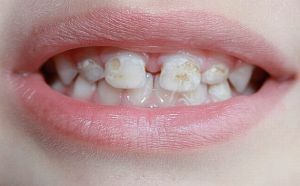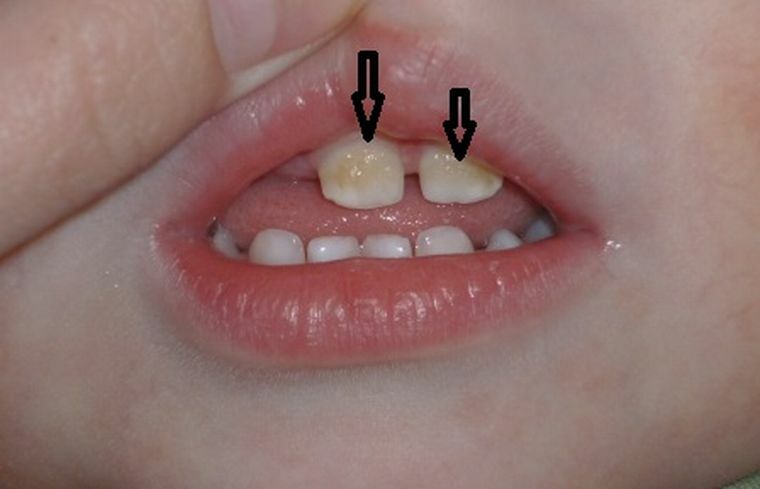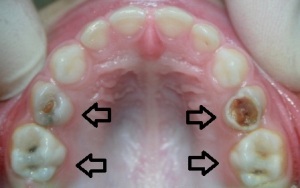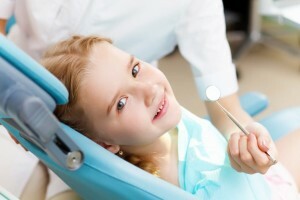 Dentists in Russia and around the world are sounding the alarm about the increased number of patients diagnosed with caries.
Dentists in Russia and around the world are sounding the alarm about the increased number of patients diagnosed with caries.
And all would be nothing, but more and more often tooth decay concerns the milk teeth and is diagnosed in children who are 2-3 years old, not more. The disease is a lesion of tooth enamel.
The tooth and gum tissues are affected by further development. If you do not resort to timely intervention and do not begin treatment, the tooth is completely destroyed and leads to inflammation of the gums. How to prevent such trouble?
Contents
- Meet - tooth decay and enamel
- About the reasons for more
- Stages of the development of the disease
- How to recognize the disease on time?
- Treatment features
- Traditional method
- Alternative methods
- Possible risks
- Preventative measures
Meet - tooth decay and enamel
Caries is a complex and slow process that starts as a result of local pH changes on the surface of the tooth under the coating. The reason is the beginning of the fermentation stage of carbohydrates, caused by microorganisms, and the formation of organic acids.
Often in children, baby teeth begin to deteriorate due to a lack of calcium in the body. In this case, dentists can diagnose the absence of calcium in the blood, bones, and, consequently, in the baby's gums, which is manifested by the lack of protection of hard tooth tissues.
About the reasons for more details
There are a lot of causes of caries on the teeth of the teeth:
- Hygiene violation and excessive eating of sweets .Children are lovers of sweet, acid whose adversely
 affect the tooth surface. If a child does not brush his teeth after eating sweets, the process of destruction begins.
affect the tooth surface. If a child does not brush his teeth after eating sweets, the process of destruction begins. - Infection with .Caries in children is rightly recognized as an infectious disease that can spread by virtue of the use of one cutlery or with kisses from parents. Genetic predisposition of .From the point of view of genetics, the process of destruction of tooth enamel and tissue begins due to the lack of any substances in the body, the structure of the dental tissue itself or the presence of bad habits that lead to mechanical damage.
Children under 2 years of age who have a lack of minerals in the dental tissue or, on the contrary, there are destructive substances in the saliva, also fall into the risk group.
In young children, caries can begin because of medical influence or if there are chronic diseases.
Also parents should protect children who are still addicted to a bottle with a pacifier, from infection and infection of the oral cavity, which also leads to the formation of caries. This applies to cases when a child falls asleep with a bottle in his mouth and, not spitting it, sleeps for a long time.
Stages of development of the disease
Dentists share 3 stages of development of children's caries:
- Surface is a small groove formed by the destruction of a small part in the enamel, the middle part of the crown remains unaffected. This stage of the development of the disorder entails strong toothaches in the baby with the use of sweet, sour. The treatment of surface destruction is carried out with the help of fluorine-containing varnishes or silver pastes.
- Medium - destruction begins in the middle part of the crown, which is referred to as dentin. Now the child feels pain when using a cold or hot. The treatment is based on the filling, where at the initial stage the preparation is carried out - removal of the destroyed black layer. It does not do without the use of a drill.
- Deep caries - entails root inflammation, tooth cyst formation, gum infection and other complications. Treatment of such teeth is only to remove. In the presence of complications, long-term gum treatment is carried out, up to surgical interventions.
If the child is still too small, all methods are used to preserve the health and the milk tooth itself.
How to recognize a disease on time?
The main symptom of caries is the child's complaints of pain and discomfort during eating.
As soon as the baby complains to his parents, they should conduct a visual examination of the oral cavity. Caries shows up with characteristic white or yellow spots on the teeth. Sometimes the baby's pains begin to disturb already at the late stage of the development of the disorder.
After the child's complaints, the dentist should immediately seek help. He will tell you what to do, including advice on further actions on the part of parents for the treatment of child caries or its prevention.

Baby tooth decay that touched the baby teeth
Features of the treatment
Treatment of tooth decay of the baby teeth is based either on retaining the tooth at an early age of the baby, or at its complete removal in the advanced stage.
Several methods are used to treat the disease, the choice of which directly depends on the condition of the tooth, the baby itself and the preferences of the parents.
Traditional method of
Traditional treatment involves the use of a drill. With its help, you can remove the upper black layer, clean the channels and seal the caries-affected tooth. 
The procedure is carried out in the following order:
- for babies it is necessary to inject an anesthetic before using the drill, today sprays or gels are used for children, less often they resort to a nap;
- with the help of a drill or with hand tools the damaged and partially destroyed fabrics are removed;
- with filling paste cleans and processes the tooth channels ;
- after the entire treatment, the tooth is sealed completely with to prevent ingestion of food into canals and nerve.
This is the easiest way to treat a toothache affected by tooth decay. True, often parents or children themselves do not want to treat a tooth, believing that it's time for him to fall out.
Not all dentists insist on treatment, some are inferior to the patient's requests, which can result in a prolonged stay without a tooth at all, which is not so pleasant - the gum may be injured.
Alternative methods of
Today, there are several types of caries treatment, where the use of a drill is not considered at all.
Such interesting methods include:
- Silvering - a special compound is simply applied to the milk tooth, where the initial stage of the lesion is noted. After the composition dries, it acquires a gray tint, which can be quite noticeable.
- Remineralization - the affected tooth is treated with mineral paste. Can be used only in the case of the initial stages of the lesion. Several treatments are used. The principle of action is the saturation of the hard part of the tooth with minerals and calcium, after which it acquires strength.
- Ozonotherapy - is based on the treatment of the affected tooth with ozone, which completely kills the bacteria. The presented technique is effective only in case of using at the initial stage of development of caries, because ozone can not penetrate into the depth of carious cavities.
- Deposition of - effective in the use of deep carious lesions. This method is based on the introduction into the carious cavity of a special composition consisting of copper hydroxide and calcium hydroxide. The composition perfectly disinfects the affected areas, while the dentist starts removing the lesions by electric current.
- Photodynamic therapy - in the process of tooth treatment, photographic materials and laser are involved. The medicine is applied to the tooth and shine through the laser, as a result of which the microbes are killed, and the damage is partially restored.
The choice of technique depends on the degree of tooth decay. But we should not forget about the financial component of the issue, because all these methods are provided in private dental clinics and can require large financial investments.
Possible risks

On the photo pulpit bilateral
The absence of timely treatment of tooth decay of baby teeth is fraught with the appearance of pulpitis - inflammation of the pulp( the core of the tooth).This defeat leads to the onset of the inflammatory process, suppuration and severe pain syndrome.
In such cases, you should urgently go to the dentist, because severe pain and suppuration later lead to intoxication and increased body temperature. Typically, such a tooth is removed under local anesthesia.
Preventative measures
Prevention of caries in children is as follows:
- Careful oral hygiene - Regular and daily brushing of teeth will ensure the timely destruction of
 bacteria.
bacteria. - Complete nutrition - the child must necessarily enter into the diet products containing calcium, and also give gnawing apples, carrots, other hard fruits and vegetables that stimulate the "work" of the gums, helping to strengthen the teeth.
- The limitations of - sweet for children - is, of course, fun, but it should be in moderation. Do not constantly offer the child chocolate and other viscous candies such as toffee. Also, it is not recommended to drink lemonades and other sweet drinks, except natural fruit juices.
- Regular visit to the dentist - the child should be examined at the dentist every 3 months.
- Refusal from bad habits - certainly, not for the child, but for the parents. Inspired by the baby, nicotine destroys the walls of the teeth.
Only timely preventive actions and treatment to the dentist will help keep your dental health. Parents should monitor the condition of the oral cavity of the child and contact the specialists in a timely manner.
